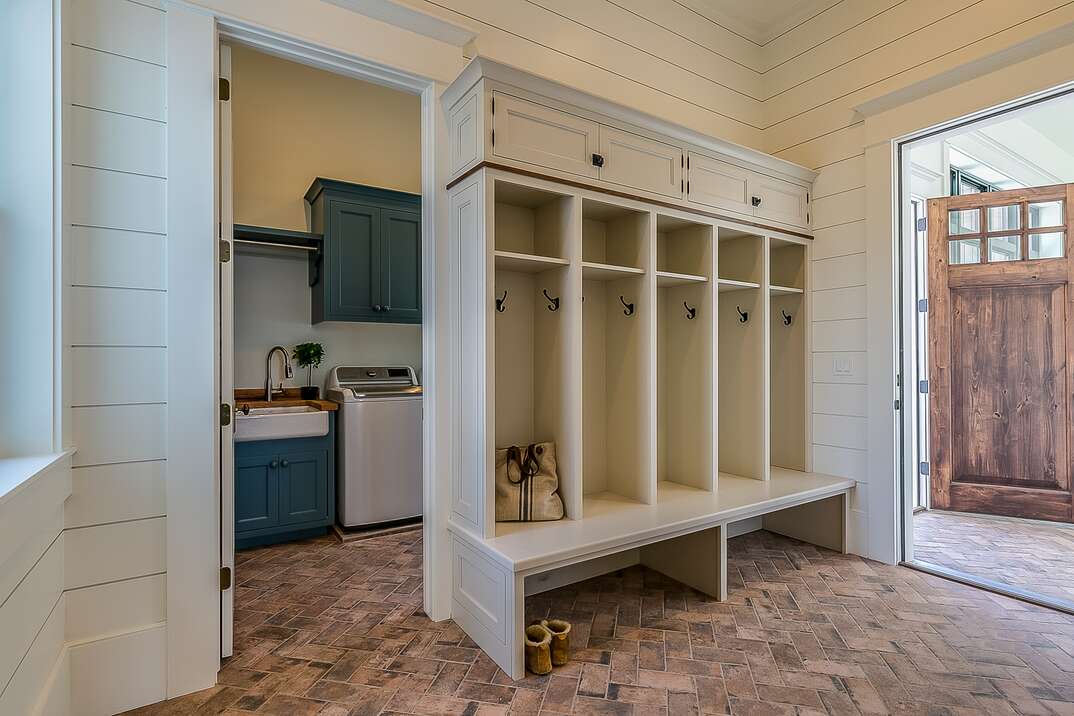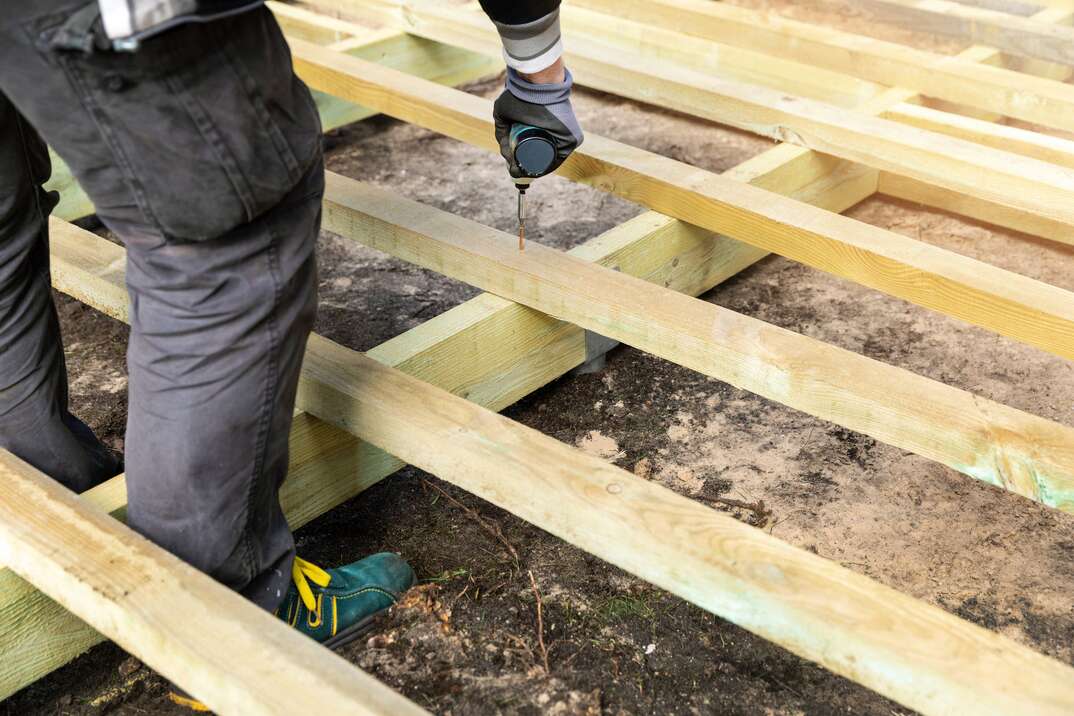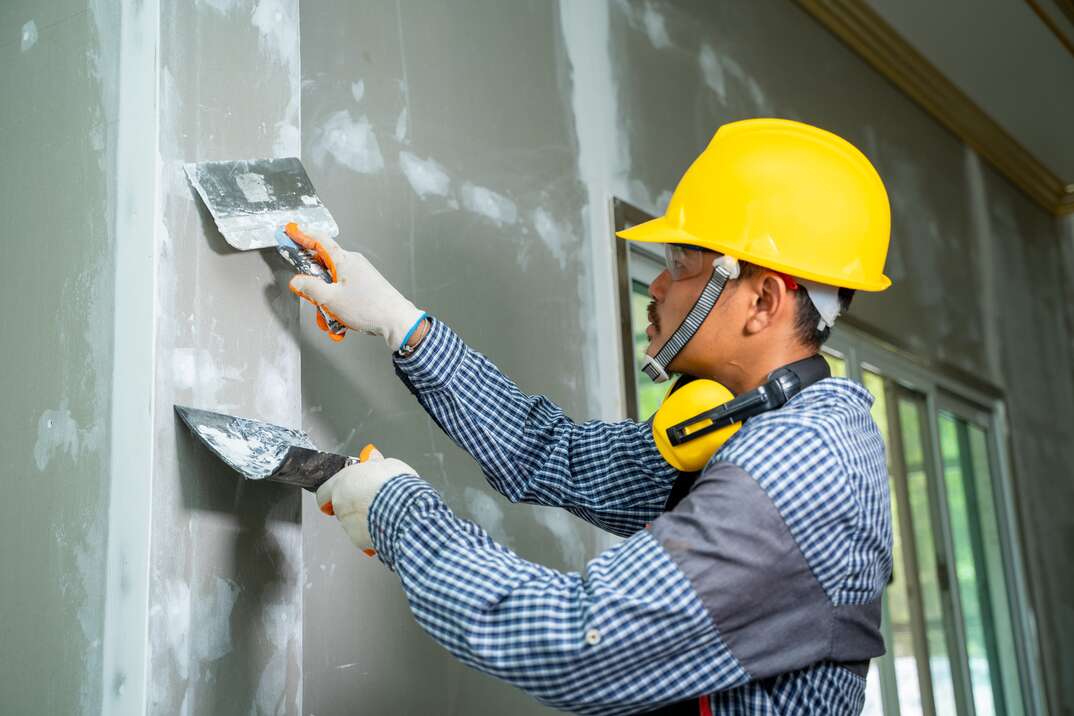Keep the Mud Out: Here's How to Build a Mudroom Addition

Building a Mudroom at a Glance
- Step 1: Build deck footing
- Step 2: Frame, insulate and board deck
- Step 3: Build wall frames and roof
- Step 4: Install wall siding and paneling
- Step 5: Add flooring and build storage
A mudroom is a great place to hang your coat and kick off your boots before entering the main residence so that you don't track dirt, mud and other debris into your home. It also functions as an additional storage space to reduce clutter.
This May Also Interest You: What’s a Mudroom?
While a mudroom can go a long way toward increasing the functionality and value of your home, adding one yourself doesn't have to be excessively expensive or complicated. With some intermediate construction knowledge, you can get the job done yourself. Here's how.
Where to Put a Mudroom
It’s ideal to pick a highly-used entrance. It could be a back door, side door or garage entrance. Basically, a mudroom belongs in any entryway where you'd like to catch mud and other outdoor debris and have a place to stash coats, gloves and other outdoor items. You can even have your mudroom built-in by converting a section of your hallway or laundry room.
Constructing a Mudroom Addition
Building an additional mudroom next to a back or side entrance is not hard. However, this type of DIY project can take 4 to 5 days to complete, depending on the design and your skill with such projects. Also, depending on where you live, you may need to apply for special permits or abide by specific building codes, so be sure to contact your local planning authority before you begin construction. You should also decide how big you want your mudroom to be; common sizes are 6-, 7- or 8-foot squares.

Step 1: Build the Deck Footing
Local building codes will generally require the use of concrete footings when building a deck, which will serve as the floor of your mudroom. Your local building codes will specify the minimum depth you should dig, which is typically below the frost line to prevent shifting during freeze-thaw cycles. They will also specify the minimum height above ground and the type of footing hardware to use.
You’ll need concrete form tubes, which can be purchased at your nearest home store, and a clamshell digger. Dig the footing holes using the clam digger, making sure their diameter is slightly bigger than that of the form tubes. You should add an extra six inches below the minimum depth when digging. Then, place six inches of gravel into the hole and tamp it down.
Cut the form tubes to length using a hand saw and place them into the hole. Mix some concrete and place it into the form tubes until they’re slightly filled. Level the surface and insert a saddle into the concrete of each form tube. Leave the concrete for 24 hours to give it enough time to dry.
Step 2: Frame, Insulate and Board the Deck
Construct two beams by combining two 2-inch by 10-inch boards and place them into the fitting saddles. These will act as support for joists when you attach them to the ledger board. Secure a 2-inch by 10-inch ledger board to your home’s foundation using an anchor bolt, making sure it is the right height. Each joist will be placed 16 inches apart, so go ahead and mark the location of each joist on the ledger board. Install joist hangers into those locations and nail them in properly — don’t miss a single nail hole. These will help anchor the joists.
Start placing the joist on top of the beams and into the hangers. Secure the joists to beams by screwing them in with woodscrews. At the end of the joists, screw in the header board, which is another 2-inch by 10-inch board. Cut metal siding to size and place it in between the joists and place fiberglass insulation batting (also cut to size) on top of the metal siding.
To finish off the deck, lay 2-inch by 4-inch boards on top of the joists and screw them in. Leave space between the boards to allow water and debris to pass through them.
More Related Articles:
- What Is a Home Improvement Loan and How Do You Get One?
- 10 Awesome Home Improvements That Won’t Break the Bank
- Turn a Spare Bedroom Into Your Dream Office
- Best Ways to Upgrade Your Home for Under $150
- The Ultimate Guide to Garage Storage Hacks
Step 3: Add Wall Frames and Roofing
Before you begin, make sure you have the wall frames designed and planned out. There should be at least one window for ventilation on one of the walls. You’ll need 2x4s for the studs and plates. Cut two boards to size (based on the needed length) and lay them flat on the ground on the 2-inch side. These will be the top and bottom plates of the frame. Clamp them together temporarily and mark the locations of the studs.
Now, it’s time to start nailing in the studs. But before you do that, you’ll have to ensure they’re the right size, which is the required height of the ceiling minus the thickness of the top and bottom plates. While installing the studs, be sure to frame the door and window. Next, nail in the noggins (also called blocking) to minimize twisting and warping.
Nail a header board between the studs of the door and window. Put more studs in the space between the header boards and top plate. Then, nail in trimmer studs for both the window and the door. Cut the bottom plate at each side of the door to create a small space at the bottom. Towards the bottom of the window, add a rough sill and cripple studs to finish building the face frame. Build the frames of the side walls using the same steps. You will not need to frame in a window or door, so this part might be a little easier. Lift the finished frames and nail them to each other, the house and the deck.
Starting at the outer edge of the top plate, install roof rafters 16 inches apart “on center.” This means that the distance between the first and second rafter will be measured from the outer edge of the first rafter to the center of the second one. And the distance between the second and third rafters will be measured from the center of the second rafter to the center of the third one and so on. To keep them upright, nail some 2-inch by 4-inch strapping.

Step 4: Install Wall Siding and Paneling
For the exterior walls, nail some plywood to the studs until they are completely covered. Cut and insert fiberglass insulation batting between the wall studs. Cover the interior walls with drywall or wood paneling. Use drywall tape to join the seams and plaster over them. With that, you’ve got the basic construction of your mudroom down.
Step 5: Deck Out the Interior
With your mudroom constructed, it is time to start adding things to it. Of course, a must-have item is a mudroom bench, which is where you’ll sit when taking off your shoes and boots. If it’s wide enough, it can also act as a storage bench, with its very own coat hooks and top shelf. The mudroom also needs general storage, perhaps with an organizer, cabinets, cubbies or shelf with crown molding.
Since the mudroom floor will see a lot of dirt, mud and other debris, it’s a good idea for the flooring to be practical. A linoleum floor is good, as it’s easy to clean and very durable. You might also want to speak to an electrician about wiring the mudroom so you can have some lighting and outlets installed. Never do any electrical work if you’re inexperienced.
Kick Off Your Boots and Hang Your Coat
Now that you have a mudroom, you no longer have to stress about your walking into a messy halfway or kitchen. Whether it is a built-in mudroom or garage mudroom, having one helps keep your home less cluttered and more organized. Also, a mudroom adds value to your home, making it more attractive to buyers in case you ever want to sell it.


